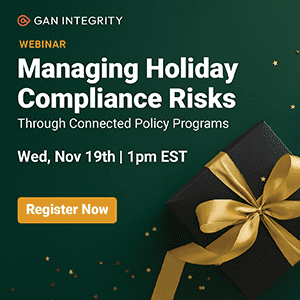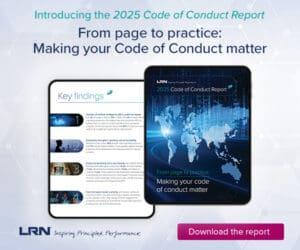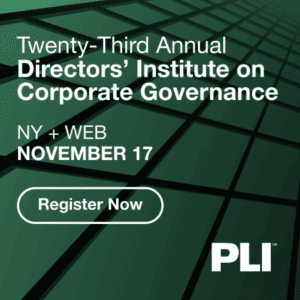In our hyper-connected world, just about every company is a tech company. As commerce and technology become increasingly intertwined, it’s even more important for senior executives and board members to ensure they have basic technological understanding, and Protiviti’s Jim DeLoach has the important questions for them to answer.
Research indicates there is a financial performance payback from a technology-savvy board. According to an analysis of the boards of U.S.-listed companies, those with boards of directors that have at least three technology-savvy members outperform other companies. These outperforming companies reported notably higher profit margins, revenue growth, return on assets and market capitalization. Note that “technology savviness” is defined as an understanding of the impact that emerging technologies will have on the industry and business model in the future.
It is also beneficial to have one or more individuals with deep technology expertise serving on the board or as advisers to the board independent of management. But the pervasiveness of technology suggests that every director should at least understand how technology enables the organization’s strategy and business model as well as the implications of disruptive innovations to their industry. Bottom line, every director should be technology-engaged. No director gets a pass.
Likewise, senior executives should be similarly engaged. But one study reports that just 7% of large companies have digitally savvy executive teams. More important, the study notes that companies with digitally savvy leaders outperform peers on revenue growth and valuation by over 48%. Only 23% of CEOs are considered digitally savvy.
Technological fluency is important. According to another global survey, risk concerns for the next decade drive a stake in the ground on technology. The results of this survey indicate that the more significant risks for the next 10 years include the rapid speed of disruptive innovations enabled by new and emerging technologies outpacing the organization’s ability to compete without significant changes to the business model.
Other top-rated risks relate to the impact of the changing workplace, the threat of new competitors, evolving customer preferences, the utilization of insightful data analytics, resistance to change and data privacy/cybersecurity. Technology is an underpinning to all of these risks. The focus on innovation and digital transformation to retain relevance has never been stronger.
Bottom line, it is a technology-driven world. Below are thoughts around improving technology fluency in the C-suite and boardroom.
Stay current with the evolving technology landscape
To stay abreast of technological developments, one approach is to bring outside experts into the C-suite and boardroom and invite them to keep the executive team and board apprised of technological trends. Alternatively, identify and lean on expert resources inside the organization — regardless of the function they are supporting.
When seeking guidance from advisers and insiders, insist on getting it in plain, practical terms. There are also many publications and subscriptions with strong technology content presented in relevant ways. Senior executives and directors should take the initiative to select the ones they find most useful.
Beyond the basics, it helps to view technology as a strategic enabler rather than a shiny object implemented for its own sake. Leaders should focus on the organization’s long-term strategic goals and how technological innovation can help reach those goals. Strategic conversations should:
- Consider the capital deployment ramifications and the related upside opportunity.
- Understand how existing legacy technology in the organization might be an obstacle to the achievement of growth goals.
- Recognize the risks emerging technologies can pose — for example, the risk of improper algorithms and bias inherent in artificial intelligence (AI) — and ensure management has implemented mitigations to address them.
In the end, it is up to each executive and director to sustain their technology currency.
What Can Your Organization Learn From the New CISA Strategic Plan?
Cyber threats against organizations of all sizes are only rising as scammers and fraudsters become more and more sophisticated. Kyung Kim and Sara Sendek of FTI Consulting dig deep into the recently released CISA strategic plan for tips on adopting the federal recommendations.
Read moreDetailsFocus on the right questions
Technology fluency is also about learning, and learning comes from asking the right questions and obtaining input from appropriate content experts. Here are key questions for the executive team and board to consider:
- Is technology identified as an integral part of the strategy and key initiatives? Does the CEO dashboard monitor technology investments that enable improvements to customer engagement, process efficiency, products and services, and competitive position?
- Are the organization’s digital transformation efforts properly prioritized to deliver the expected value and results — for example, are multi-year plans reevaluated every three to six months in view of changing markets and customer needs? Are plans resourced with the requisite skill sets, or is help needed?
- What are the long-term plans with respect to hybrid work environments? How will access and connectivity be enabled to ensure productivity, safety and security in the future, considering the next generation of mobile connectivity and systems and data access? How will the organization build on and enhance its culture in a hybrid workplace?
- What programs is management considering to protect the organization’s critical data and information assets and comply with global data privacy requirements?
- How robust are the company’s business continuity, crisis management and disaster recovery plans? Are contractors and outside services in alignment to support those plans? Does the technology infrastructure enable business resilience, or hinder it? If a security breach occurs, how will operations be affected, and how quickly can the company respond?
- Regarding the processes management chooses to automate, are they sufficiently focused, streamlined and simplified such that automation makes sense? Is the selection of a process for automation strategic — for example, to focus employees on more complex, value-added tasks?
Executive management and the board should consider these areas, as well as the resources needed to ensure the success of technology improvement initiatives.
Be cognizant of how technology impacts talent availability
Technology fluency is also about understanding the implications of digital disruption. For example, there are positive and negative impacts of remote work on the workforce. Employees have experienced new opportunities in terms of team dynamics, collaboration and culture-building. Remote work has enhanced well-being by reducing long commutes and has allowed working parents more flexibility.
However, technology has implications to relationships and has a downside from a well-being standpoint, as it has become increasingly intrusive in terms of everyone’s personal space. People are exhausted and plugged in too much and have found it difficult to reclaim private time. Technology has resulted in significantly higher productivity levels but has also increased the risk of burnout. This may be one of the contributing factors to the so-called “Great Attrition.” As noted earlier, potential impacts on organizational culture must be addressed as companies trend toward hybrid work environments.
Dependence on technology has led to talent availability becoming a key issue for boards and executive management to address. Long term, the limited pool of technology professionals will be drained quickly by overwhelming demand for skilled and experienced talent as new technologies take root in the design and execution of business models.
This market reality creates an obligation to provide learning opportunities pertaining to emerging technologies. How is the organization thinking about upskilling and reskilling its workforce to address, at least in part, what many see as a dwindling availability of talent? The proverbial “search for the purple squirrel” — finding the candidate with the requisite education, experience, and range of qualifications and skills that perfectly fit a job’s requirements — has gotten harder.
That is why human capital management strategies require a revisit. For example, it may be necessary to find people with a strong base of cognitive and adaptive skills and upskill them into the use and application of new technologies. Employees should be motivated and incented to keep themselves current and develop new areas of knowledge and skill sets. People should learn on the job. Continuous learning, upskilling, agility and innovation should be emphasized as core values and supported by executive management and the board.
None of this will happen organically. Training and upskilling must be intentional and pushed by management, with encouragement from the board. Organizations may find it necessary to seek technology talent everywhere, including outside the region or country. The board and management should engage in strategic discussions to explore options. Because this challenge has implications to broader national immigration policy and future GDP growth, forward-looking companies should factor talent availability into their outreach to legislators and regulators.
Cyber risks come with the technology territory
Of course, cybersecurity is an integral part of the technology conversation. First, cyber incidents of today are very different from the incidents of a few years ago. The landscape changed dramatically during the pandemic as organizations transitioned to remote workforce models. Many people worked — at least for a period of time — on less secure or even unsecure networks and modems, necessitating a planning process to protect company systems and data.
Second, cyber insurance companies are more demanding and discerning in underwriting policies and settling claims in the event of an incident. The high bar requires extensive organizational resources to obtain coverage. Boards should consult with management to ensure that appropriate steps are being taken.
Third, organizations should have a cyber response team in place — with legal, forensics, communications and other resources. Such teams should be steeled through preparation and practice to ensure they are at the ready. To that end, there is a difference between a cyber incident and cyber breach. The former represents a violation of an organization’s security policy. The mere presence of malware inserted in a system by a cybercriminal is a cyber incident but not a breach. A breach occurs only when there is unauthorized access to data or information — for example, when malware compromises systems and data.
This distinction is important when drawing up contracts, as their terms dictate actions required of the contracting parties. Ordinarily, a cyber breach must be reported publicly. General or outside legal counsel should be engaged to determine the appropriate courses of action depending on the circumstances in each case.
Finally, many services and products are available to protect the organization from incidents and breaches. Multi-factor authentication is an example. Everyone in the organization should be required to use it on company systems to provide a critical layer of protection.
Summary
It is a technology-driven world, one in which senior executives, directors and other leaders should be technology fluent. As companies design business models for speed and secure the talent to compete and win in the digital era, the top of the organization should be sufficiently technology-engaged in its strategic thinking and operational execution. Thinking digital is more likely to result in acting digital than vice versa. Leaders who understand this vital distinction are more likely to attract the talent they need on their team and achieve their goals faster than those who choose to react to innovations happening around them.




 Jim DeLoach, a founding
Jim DeLoach, a founding 








